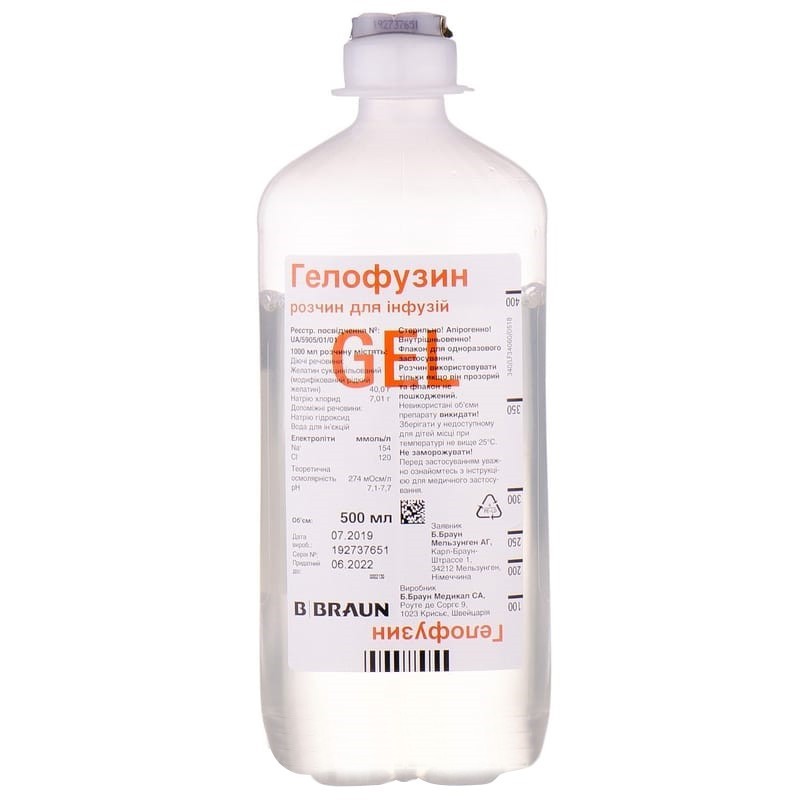



 Secure and encrypted payment processing
Secure and encrypted payment processing We ship to over 40 countries including the USA, UK, Europe, Australia and Japan
We ship to over 40 countries including the USA, UK, Europe, Australia and Japan Guaranteed refund or reship if you haven't received your order
Guaranteed refund or reship if you haven't received your orderGelofusine is a 4% solution of succinated gelatin (also known as modified liquid gelatin) in 0.9% sodium chloride solution with an average molecular weight of 30,000 da. the relative viscosity of a solution of 1.9 at a temperature of 37 ° C, a colloidal osmotic pressure of 34 mm RT. Art. due to succination, gelatin molecules become more negatively charged and therefore more extracted. Due to the shape of the molecules, gelatin produces a greater volumetric effect than unsuccinated protein chains with the same molecular weight. the volumetric effect of Gelofusine is equivalent to the amount of injected solution, that is, 100%, and lasts for 3-4 hours. Thus, Gelofusine is a substitute for blood plasma, but does not have a plasma-expanding effect.
After infusion, Gelofusine quickly spreads in the intravascular space and partially - due to the low molecular weight - in the interstitial space. The volume-dependent effect of Gelofusine lasts for at least 3-4 hours. It is excreted mainly in the urine, only a small amount - with feces, only about 1% of the injected solution is metabolized. Small molecules are excreted directly by glomerular filtration.
For the prevention and treatment of absolute and relative hypovolemia (for example, with shock due to hemorrhage or trauma, blood loss during surgery, burns, sepsis); for the prevention of arterial hypotension (for example, in connection with epidural or spinal anesthesia); with hemodilution; extracorporeal circulation (heart-lung apparatus, hemodialysis) when diluting compatible drugs, such as insulin.
In / in the total dose, duration and rate of infusion depend on the volume of blood loss or blood plasma, as well as on the condition of the patient; if necessary, they are corrected taking into account the controlled parameters of blood circulation, for example hell. you should be aware of the danger of circulatory overload due to too fast infusion or the introduction of too much of the drug. infusion should be started immediately after attaching the package with r-rum to the system.
To identify possible anaphylactic / anaphylactoid reactions, the first 20-30 ml of the drug is administered slowly under medical supervision.
Adults are prescribed in the following doses:
| Indication | Recommended Medium Dose |
|---|---|
| Prevention of hypovolemia and arterial hypotension, treatment for mild hypovolemia (for example, with small blood loss, plasma loss) | 500-1000 ml for 1-3 hours |
| Treatment of severe hypovolemia | 1000–2000 ml |
| Critical situation, a threat to life | 500 ml in the form of a rapid infusion (under pressure), then, after improving the hemodynamic parameters of the cardiovascular system, Gelofusine is infused in an amount equivalent to a deficiency of bcc |
| Hemodilution (isovolemic) | The volume of Gelofusine administered should be equivalent to a deficiency in blood plasma, but no more than 20 ml / kg / day |
| Extracorporeal circulation | The dose depends on the system of circulation used, but usually is about 500-1500 ml |
Maximum daily dose: the therapeutic limit depends on the effect of dilution.
When the hematocrit decreases to below 25% (for patients with cardiovascular or pulmonary insufficiency - 30%), an erythrocyte mass or whole blood is required (Gelofusine can be used in parallel with a blood preparation, the speed and volume of infusion depend on the patients clinical condition). The maximum daily dose depends on the volume of lost blood or blood plasma, as well as on the patients condition. For example, with massive blood loss, if necessary, transfusion of up to 10-15 l of a solution is possible for 24 hours.
The maximum infusion rate depends on the condition of the coronary blood flow.The rate of administration can be increased by pressing the container or using an infusion pump. Before administration, Gelofusine should be heated to a temperature of 37 ° C.
When infusing under pressure (for example, using a cuff or infusion pump), all air must be removed or evacuated from the container with the air inside, as well as from the device, since there is a risk of air embolism during the infusion.
Further information: it is necessary to control the water-electrolyte balance of the body; Replace electrolytes if necessary. The introduction of the drug can affect a number of laboratory parameters: ESR, urine specific gravity, results of non-specific determination of protein (for example, using the biuret method).
Particular care should be taken when administering the drug to patients with blood clotting disorders, renal failure, and chronic liver diseases.
Hypersensitivity to gelatin, hypervolemia, hyperhydration, severe heart failure, severe bleeding disorders, severe renal failure, recent myocardial infarction.
With the introduction of Gelofusine, as well as other colloidal plasma-replacing drugs, allergic (anaphylactic / anaphylactoid) reactions of various severity can occur: urticaria, hyperemia of the skin of the neck and face, in rare cases - decreased hell, bronchospasm, anaphylactic shock, cardiac arrest and breathing.